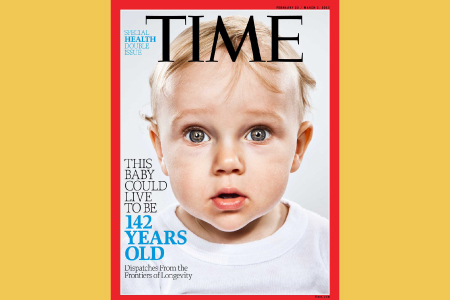
This week’s cover of Time presents a bit of conjecture meant to engage the reader and sell copies. But when they rhetorically state that this cute ‘lil guy could live to be 142, they fall well short of the mark…
When I spoke with the world’s expert in supercentenarians (people over 110 years old), my late friend, Steve Coles, told me that when he began studying these special people forty years ago, he was certain that the numbers of people aged over 110 years would increase but much to his surprise, it never did. It became clear to him that despite advances in the modern lifestyle and science, the number remained fixed at about sixty for the last four decades.
Ready for some mixing of metaphors? We must consider counting the number of extremely old people to be like playing musical chairs. You have a song, let’s say it’s “Pop! Goes the weasel”. How many people are going to be left in the game with only 15 seconds left in the song? It will always be the same assuming the game is designed around the length of the record. Now replace the record with a longer song, say “Stairway to Heaven”; you might require almost eight minutes to get to the last sixty humans. This would be analogous to increasing human lifespan by slowing aging.
Such an intervention, perhaps brought to you by big pharma as I blogged about recently, might push the appearance of the “sixty club” to 142 years. But what I predict for our future is what Aubrey DeGray calls “negligible senescence” and that requires changing the rules of the parlor game like Captain Kirk in the Kobayashi Maru scenario.
Most laypeople and scientists think there must be some as yet undiscovered genetic traits shared by those who enjoy extreme longevity. If there is, Stanford researchers couldn’t find it in the genes of the world’s oldest people as shown in this study:
Just so, what was so special about the last two people who fought over the final musical chair in your third grade classroom? Nothing. And so we must face the negative findings of this study and accept that it is everything, not one thing or a gene that determines longevity. Jeanne Calment smoked until her death at 122 and most people would not start smoking because of that fact.
But when you use telomerase activation or other adaptogens to prevent telomere erosion and stem cell damage, then the game changes. It is as though musical chairs is replaced by 24 hour satellite radio. In that scenario, there would be no maximum lifespan and chairs enough for everyone. Learn more about this concept in this brief interview I did:
To enjoy a philosophical sci-fi story that I wrote about extreme longevity, check out my graphic novel trailer:





1 thought on “The Cover of Time, musical chairs, and the death of death itself”
Hi. Interesting Point of view ( as often from Ed 🙂